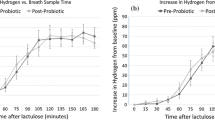Abstract
To evaluate the role of urinary indican excretion and several common absorptive tests as predictors of bacterial colonization in the human jejunum, we analyzed the relationship between indican excretion and quantitative jejunal cultures, tryptophan absorption, enteric protein loss, fecal nitrogen excretion, D-xylose and lactose tolerance tests, and B12 and fat absorption in 40 subjects. Indican excretion correlated poorly with jejunal colony counts (r=0.22). Neither tryptophan load or absorption, nor nitrogen excretion were related to indicanuria, but there was a modest correlation between enteric protein loss and urinary indican values (r=0.54). Lactose tolerance tests and D-xylose, B12 and fat absorption showed no predictive value for identifying patients with high colony counts. Compared to quantitative small bowel culture, none of the tests studied provided suitable methods for screening for bacterial contamination of the human jejunum.
Similar content being viewed by others
References
Neale G, Tabaqchali S: Value of measuring urinary indican excretion. Gut 7:711, 1966
Tabaqchali S, Okubadejo OA, Neale G, Booth CC: Influence of abnormal bacterial flora on small intestinal function. Proc R Soc Med 59: 1244–1246, 1966
Tomkin GH, Weir DG: Indicanuria after gastric surgery: An evaluation of the diagnosis of the blind loop syndrome. Q J Med 41:191–203, 1972
Wood WA, Gunsalus IC, Umbreit WW: Function of pyridoxal phosphate: resolution and purification of the tryptophanase enzyme ofE coli. J Biol Chem 170:313–321, 1947
Gooder H, Happold FC: The tryptophanasetryptophan reaction: The nature of the enzymecoenzyme-substrate complex. Biochem J 57:369–374, 1954
Dalgliesh CE: Routes for tryptophan degradation used principally by microorganisms. Adv Protein Chem 10:108–123, 1955
Posner HS, Mitome C, Udenfriend S: Enzymic hydroxylation of aromatic compouds II Further studies of the properties of the microsomal hydroxylating system. Arch Biochem Biophys 94:269–279, 1961
Fordtran JS, Scroggie WB, Polter DE: Colonic absorption of tryptophan metabolites in man. J Lab Clin Med 64:125–132, 1964
Bryan GT: Quantitative studies on the urinary excretion of indoxyl sulfate (indican) in man following administration ofl tryptophan and acetyl-l-tryptophan. Am J Clin Med 19:105–112, 1966
Kowlessar OD, Haeffner LJ, Benson GD: Abnormal tryptophan metabolism in patients with adult celiac disease with evidence for deficiency of vitamin B12. J Clin Invest 43:894–903, 1964
Neale G, Lambert RA, Gorbach SL: The production of indole by bacteriain vitro. Gut 10:1056–1057, 1969
Hamilton JD, Dyer NH, Dawson AM, O'Graly FW, Vince A, Fenton JCB, Mollin DL: Assessment and significance of bacterial overgrowth in the small bowel. Q J Med 39:265–285, 1970
Greenberger NJ, Saegh S, Ruppert RD: Urine indican excretion in malabsorptive disorders. Gastroenterology 55:204–211, 1968
Beeken WL, Kanich RE: The microbial flora of the upper small bowel in Crohn's disease. Gastroenterology 65:390–397, 1973
Curzon G, Walsh J: A method for the determination of urinary indoxyl sulfate (indican). Clin Chim Acta 7:657–663, 1962
Hess SM, Udenfriend S: A fluorometric method for the measurement of tryptamine in tissues. J Pharma Exp Ther 127:175–177, 1959
Steyrmack A: Quantitative Organic Microanalysis, 2nd ed. New York, Academic Press, 1961, Chap. 8, p. 188 ff
Young VR, Hussein MA, Murray E, Scrimshaw NS: Plasma tryptophan response curve and its relation to tryptophan requirements in young adult men. J Nutr 101:45–60, 1971
Beeken WL: Clearance of circulating radiochromated albumin and erythrocytes by the gastrointestinal tract of normal subjects. Gastroenterology 52:34–41, 1967
VanderKamer JH: Total fatty acids in stool. Standard Methods of Clinical Chemistry, Vol II. D Seligson (ed.) New York, Academic Press, 1958, pp. 34–39
Schilling RF: Diagnosis of pernicious anemia and other vitamin B12 malabsorption syndromes with radioactive B12. Nuclear Medicine. WH Blahd (ed). New York, McGraw Hill Book Co., 1965, p. 841
Roe JH, Rice WE: A photometric method for determination of free pentoses in animal tissues. J Biol Chem 173:507–512, 1948
Michael AF, Drummond KN, Doeden D, Anderson JA, Good RA: Tryptophan metabolism in man. J Clin Invest 43:1730–1746, 1964
Gorbach SL, Tabaqchali S: Bacteria, bile and the small bowel. Gut 10:963–972, 1969
Hill MJ, Drasar BS: Degradation of bile salts by human intestinal bacteria. Gut 9:22–27, 1968
Shimada K, Bricknell KS, Finegold SM: Deconjugation of bile acids by intestinal bacteria: A review of literature and additional studies. J Infect Dis 119:273–281, 1969
Wolf H, Brown RR: The effect of tryptophan load and vitamin B6 supplementation on urinary excretion by metabolites in human male subjects. Clin Sci 41:237–248, 1971
Egger G, Kessler J: Clinical experiences in a simple test for the detection of bacterial deconjugation of bile salts and the site and extent of bacterial overgrowth in the small intestine. Gastroenterology 64:545–551, 1973
James OFW, Agnew JE, Bouchier IAD: Assessment of the 14-C-glycocholic acid breath test. Br Med J 3:191–195, 1973
Sherr H, Yasuhito S, Newman A, Banwell JG, Wagner HN, Hendrix TR: Detection of deconjugation of bile salts by a convenient breath analysis technique. N Engl J Med 285:656–661, 1971
Fromm H, Hofmann AF: Breath test for altered bile-acid metabolism. Lancet 2:621–625, 1971
Author information
Authors and Affiliations
Additional information
Supported by a grant from the John A. Hartford Foundation, Inc., and by Grant 109 from the General Clinical Research Centers Program of the Division of Research Resources, National Institutes of Health.
Rights and permissions
About this article
Cite this article
Mayer, P.J., Beeken, W.L. The role of urinary indican as a predictor of bacterial colonization in the human jejunum. Digest Dis Sci 20, 1003–1010 (1975). https://doi.org/10.1007/BF01071187
Issue Date:
DOI: https://doi.org/10.1007/BF01071187




